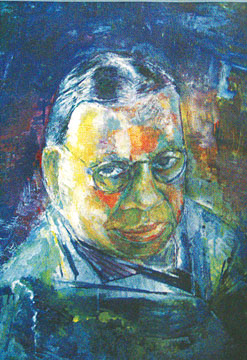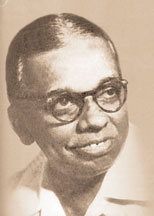Unique portrait artist
Old Master - By Tissa Hewavitarana
Today extremely individualistic art is almost the rule among serious
independent painters all over the world. On the other hand, art that is
popularly termed 'academic' and is described by its advocates as
traditional - and sometimes as that which alone is 'sane' or competent
or healthy - is indeed far from any seriously maintained academic
tradition. In fact, the genuine academic painter, the painter who is
able to express himself fully within a great tradition and with complete
understanding of its possibilities and limitations, is a very rare bird
indeed, and a fortunate one. Such a painter was J. D. A. Perera.
 Born in Gampaha in 1897 J. D. A. Perera showed early talent as a
young boy of 12 years age. He had his education at the bilingual school
at Gampaha, and the village temple where he learnt Sinhalese and Pali.
After completing his education at Ananda College and later at Wesley
College, he joined the Ceylon Technical College since he had a natural
flair for art. Born in Gampaha in 1897 J. D. A. Perera showed early talent as a
young boy of 12 years age. He had his education at the bilingual school
at Gampaha, and the village temple where he learnt Sinhalese and Pali.
After completing his education at Ananda College and later at Wesley
College, he joined the Ceylon Technical College since he had a natural
flair for art.
He came under the influence of C. F. Winzer, one of the most
competent English painters who came to Ceylon (then) to teach art. While
following art classes at the Ceylon Technical College, J. D. A. was
noticed by C. F. Winzer who told the principal "Here is one who can
draw."
In 1923 he was appointed art instructor at Technical College and
later art master in succession to the late D. John Perera. J. D. A. in
1946 was awarded the first government scholarship for art which took him
to Europe where he came in contact with the foremost painters of his
time. Most of J. D. A.'s work of art are on permanent exhibitions. Some
adorn the treasure houses and salons of the world, others have been
gifted or taken away as mementos and others have been sold. His
portraits hang in many European capitals and in London and Rome. They
are of the Royal Academy style.
Portrait painting was his special field. His portraits retained his
natural simplicity. He surprises his sitters while they are in the
process of thinking. The pictures seem to breathe and talk. His
portraits are, in the trust sense, living pictures. They sit at ease in
an unobtrusive background - a grey wall, a table, or a curtain. Some of
these sitters are from the highest nobility - just ordinary human beings
whom by an accident of birth have invested with extraordinary powers.
J. D. A. was known as Queen's House painter nearly every governor
would commission him to paint a portrait. J. D. A. had two of his
portraits of Sri Lanka personalities accepted by the Royal Society of
Portrait painters in London. The portrait of Dr. Senarath
Paranawitharana the archaeological commissioner and Donald Abeysinghe.
These were hung along on the line at the exhibition art galleries of the
Royal Society of British arts in London. J. D. A. was a portrait artist
par excellence.
As a painter his best works of art in his 50 years are "The portrait
of an old man (in London) and "Portrait of a poet" (in Rome). His
paintings were hung in the Leicester galleries, the Paris salon, the
National Portrait Society, the Royal Society of Portrait Painters and
the galleries Bretan in Paris.
He also had the rare distinction of being made a member of the
Chelsea Arts Club. He occupies the centre stage in the world of art
education in modern Sri Lanka. He started the Government College of Fine
Arts in 1953 for the teaching of drawing, painting, arts, crafts,
sculpture, music and dancing. He later became the principal of the
Government College of Fine Arts from which post he retired in 1956. He
was fifty years a painter and half of the time a dramatist as well.
 His theatre productions were melodramatically spectacular and in the
Tower Hall tradition. Some of these were crowd pullers such as 'Vessantara',
'Siri Sangabo' and 'Harischandra.' They contributed greatly to the
Sinhala drama revival of that era. All the well-known John de Silva
plays were at that time produced by J. D. A. Perera. He also served as
the president of the Sinhala Drama panel of the Arts Council. His theatre productions were melodramatically spectacular and in the
Tower Hall tradition. Some of these were crowd pullers such as 'Vessantara',
'Siri Sangabo' and 'Harischandra.' They contributed greatly to the
Sinhala drama revival of that era. All the well-known John de Silva
plays were at that time produced by J. D. A. Perera. He also served as
the president of the Sinhala Drama panel of the Arts Council.
It was at Ceylon Technical College he met his future wife Brintilda
Karunatilaka. He later got married to her who under her stage name was
known as 'Chandraleka', one of Sri Lanka's most celebrated dancers. Both
travelled to India while she learned oriental dancing under the famous
dancer Gopinath. J. D. A. travelled extensively in India and visited all
the cultural centres including Uday Shankar's dance school at Almora.
The Devan of Travancore Sir C. P. Ramasamy Aieyer sponsored a dance
recital by Chandraleka at the palace of Maharajah of Travancore.
After his return to Sri Lanka he held a 3 man exhibition with David
Paynter and Karl Kasman. Earlier his paintings had been hung at the
Delhi Inter - Asian Exhibition. His sojourn abroad was of great help to
the cause of art in this country. He kept at his task of creating beauty
until the last stages of his life. And, to the curiosity of his
countless admirers he left his pallette on September 7, 1967.
www.tissahewavitarana.com
|

